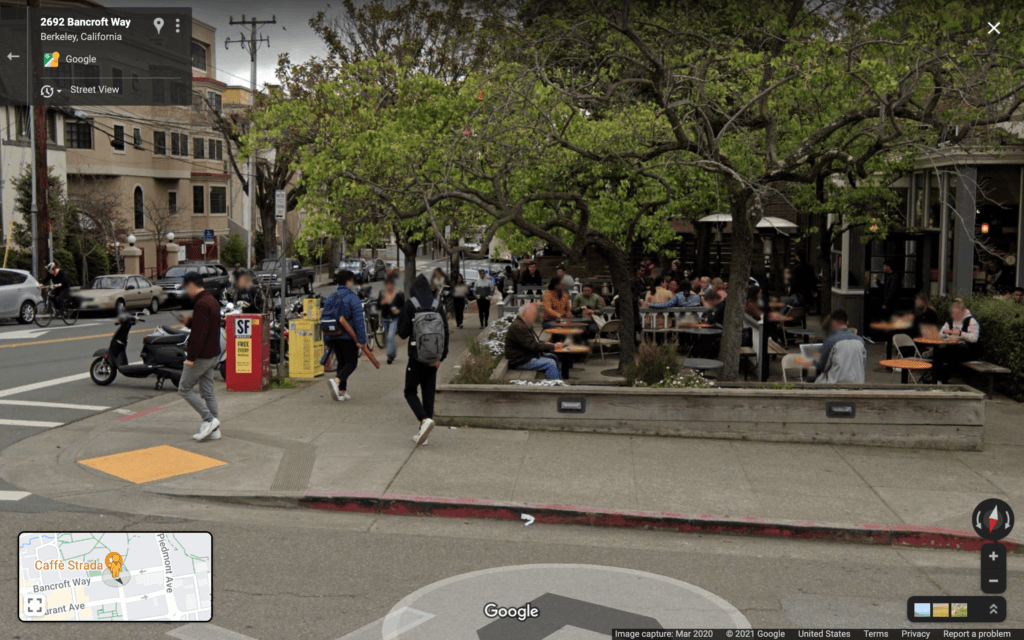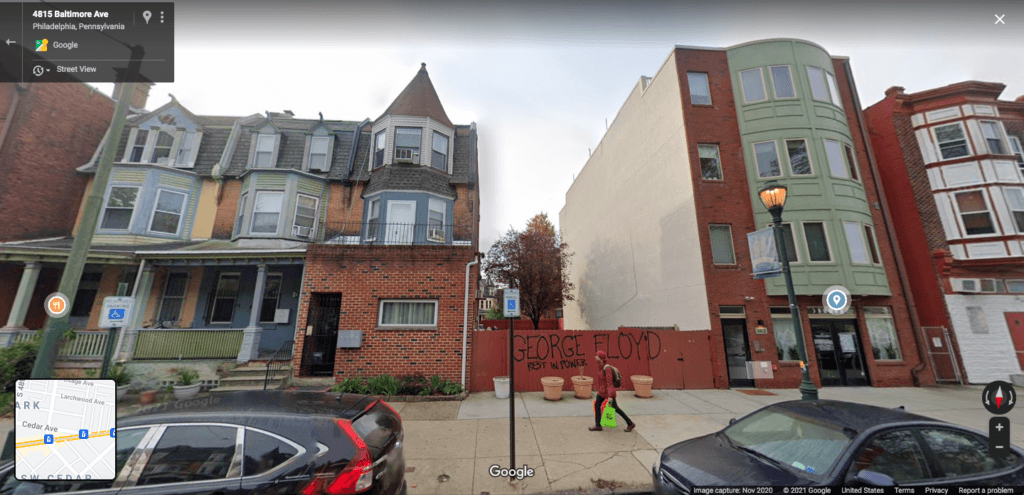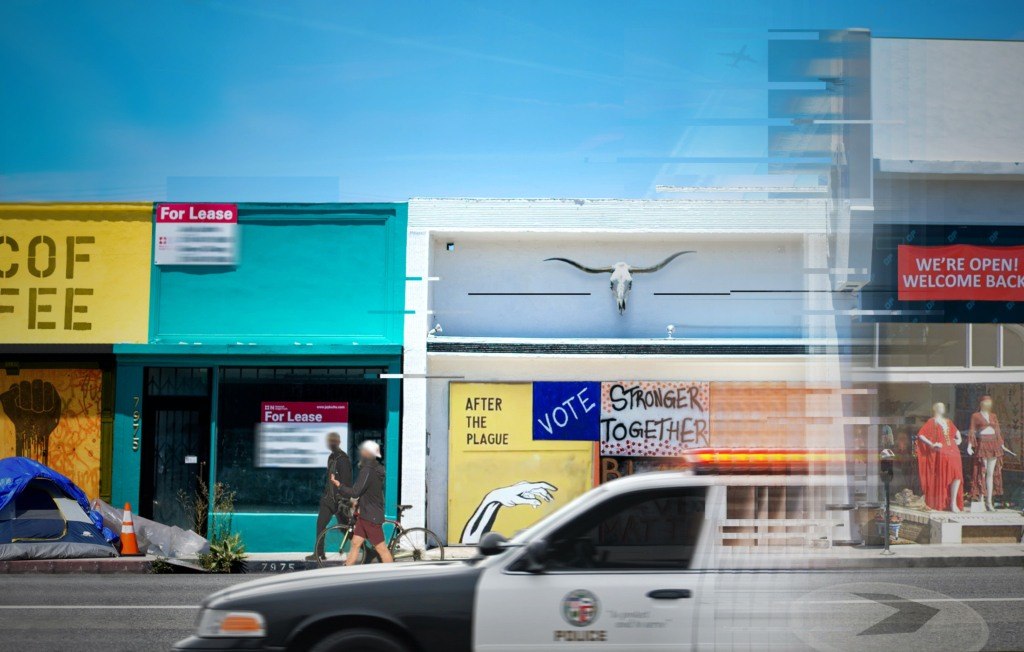For much of the pandemic, it seems, Google Street View drivers were essential workers. As Covid cases were spiking in the U.S. in March and November, Google’s independent contractors headed to work. Their role, not dissimilar to that of Amazon or Uber Eats delivery drivers, entailed traversing the built environment, snaking through the freeways, boulevards, dirt roads, and cul-de-sacs that constitute their workspaces. Log on to any given American city and you’ll see the fruits of their labor.
What constitutes a sufficient visual commemoration of the pandemic’s first year?
Many of the cultural signifiers of life under viral rule are present in this latest installment of Google’s decade-long photographic mapping project. In Berkeley, images dated to March 2020 show a not-yet shuttered Telegraph Ave, where students remain huddled outside of cafes, largely unmasked and unaware of what will hit them the following week. The occasional, anticipatory mask is visible behind a de-identifying face blur. Based on the number of people stopped in the middle of the sidewalk, hunched over their phones, texting manically, one assumes these photos were taken during the first week of March, when wealthy Americans began to plan their escape.

Street View was there, too, as April’s barren streetscapes became the summer’s packed promenades. It took stock as construction workers raced to secure the flimsy, plywood party walls of outdoor dining enclosures, and later, saw these enclosures overflowing, even as the streets around them were roiling. We don’t see the summer’s protests themselves, but we see the marks they left behind: entire boulevards boarded up, police cruisers so pervasive in Black neighborhoods that even they can’t duck Street View’s all-seeing eye.

By the time New York was photographed in October and November, testing had become widely available, the mechanisms of safety second nature. Even so, as the holidays approached, every City MD clinic in the city was accompanied, invariably, by a line stretching down the street and around the corner. While those positive tests produced the epidemiological archive we know now as Covid’s third wave, Street View produced an archive of waiting — for the line to start moving, for the test to come back negative, for the whole thing to be over.
People also waited for the necessities of life. You may have seen an image in the New York Times last spring showing a bird’s-eye view of an endless line of cars entering a San Antonio food bank. When I locate the same food bank on Street View, photographed most recently in 2019, it’s just an empty parking lot, expansive in a way only possible in Texas. Its banality foreshadows what was to come. Against photojournalism’s sensationalism, Street View conveys an affective blankness. In place of an individual narrative flashpoint, it offers up a sprawling record of a million moments of public life. The suffering, so front and center in the Times, is here, just out of frame.
Last spring, many people — from art historian Sarah Lewis in the Times to Colin Dickey in this magazine — asked why had we failed to visually represent Covid. Lewis fixated on the “absence of…a representative, visual archive of the staggering human toll of the crisis from which might emerge, in time, our emblematic pictures.” Dickey elaborated that, historically, visual referents of illness like scars and lesions are what make a pandemic “real to the general public… These physical markers are more than just symptoms; they are the means by which we conceptualize the disease into discursive space.” During this pandemic, the virus’s toll at the scale of the economy was perhaps more outwardly represented than its effect on individual bodies. To those sheltered from its clear physiological markers, it hid in plain view.
Just over a year later, more than 600,000 people have died from Covid in the United States. Now that infection rates have dropped precipitously, at least for the moment, a new question emerges: What constitutes a sufficient visual commemoration of the pandemic’s first year? What artistic or documentary pursuit could evoke everything from the banalities of quarantine to the desperation of unemployment, from the devastation of mass death to the possibility of life beyond it?
The answer, of course, is that nothing could do all this adequately. What Street View offers instead is a reflection of the everyday social relations of pandemic life. It is insufficient in all the ways we might expect: lacking in narrative, devoid of intimacy and sensorial texture, filtered through a screen that one can stare at without really seeing anything at all. But for so many of us, wasn’t 2020 all these things, too?
I can’t say why, under lockdowns in several American states, Google felt it wise — essential, even — to continue mapping. (Unsurprisingly, the company did not respond to my request for comment.) It is worth noting, though, that as far as Google products go, Street View is one of the least practical. Its purpose to users is almost entirely frivolous (21st Century travel replacement; curb appeal investigator; net art source material). Its visual data, like all data, can be monetized — Alphabet recorded record profits during the pandemic — but I am interested more in the use value of this cache to users, present and future, as an abject memento of this time.
Street View offers a reflection of the everyday social relations of pandemic life. It is insufficient in all the ways we might expect
By way of example: a few weeks ago, I was on Street View in West Philadelphia, where I grew up, when I haphazardly encountered my own mother’s likeness. She is standing at the edge of a neighborhood park, midway through an evening walk. From the massive signs reading “VOTE. MAKE A PLAN.” — installed every 10 feet along the avenue — one can discern that this is election season. She is dwarfed by the Street View car’s eight-foot-tall, roof-mounted cameras, which capture her alone, unaware that she is being immortalized.
The photograph’s punctum, to borrow a phrase from Barthes (who, incidentally, coined the term in relation to a photograph of his mother), is the knowledge that this is one of the only times I will see my mother as she exists in the world alone. This is not a posed photograph by a friend but an interjection by a stranger; it is not candid in the way we might describe an intimate photograph taken when its subject is not looking, but a public, and incidental record of the everyday.
It’s easy to zoom, accidentally, from 2017 to 2020 and back to 2008, shifting awkwardly through layers of annual rephotographing. In a few years, 2020’s peculiar layer may seem an aberration
Contained in the non-relationship between my mother and this anonymous driver-cum-portraitist is a crucial dimension of pandemic life: its tendency to more intensely mediate relationships through technology and route interactions through the tools of capital accumulation. Street View takes this process to an extreme. Not only is this driver’s fleeting encounter with my mother monetized as the technology recognizes her face, but I, too, experience my mother through the filter of capital as I relate to her on Street View. To some extent, this is how most non-domestic relationships transpired in 2020: if not filtered through the screen, then filtered through the mask, and if not through the mask, then through the possibility of contamination.
I’ve referred to the Street View 2020 photos as an archive, but unlike real archives, this one hasn’t been meticulously processed. On Street View, it’s easy to lose your place and never find it again — to zoom, accidentally, from 2017 to 2020 and back to 2008 again, shifting awkwardly in and out of layers of annual rephotographing. Perhaps in a few years, as we sink deeper into collective amnesia, 2020’s peculiar layer — with its scenes of emptiness implying desperation — will come to seem an aberration, something we’d rather overlook. After all, archiving disaster is not listed among Google’s stated “Street View Success Stories,” although increasing tourism to Zimbabwe is.
In the absence of a citizen corps of photographers, such as those employed by the Federal Art Project during the Great Depression — a program that, art-historically, is easy to critique for its reliance on charitable empathy, but which feels somewhat radical from our contemporary vantage — this is the record we have. Like many tools of techno-capitalism, it passes for a public sphere in the absence of a more robust commons. “As the Covid-19 crisis in New York City has spiraled out of control,” Colin Dickey wrote last May, “the temporary field hospitals set up in Central Park, the refrigeration trucks as temporary holding spaces for bodies too numerous to be processed by funeral homes, and the medical ship USNS Comfort all seemed poised to occupy that visual space.” But what this catastrophe of global proportions looked like, day to day, was something more banal. An empty parking lot, a long line, a photo of one’s mother standing meekly on the curb.
GUIDED TOURS is a column that looks at historical or cultural sites in pictures, led by a knowledgeable escort. Tours can last the length of a single exposure in a fixed time, or the length of a single block, or they can pass through multiple sites and last for decades. If you’d like to nominate a place, please walk us through it.
